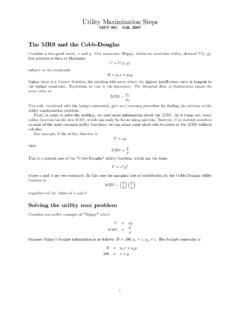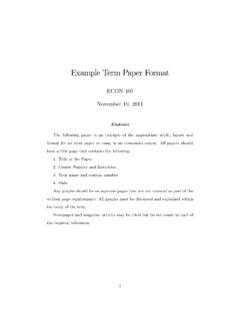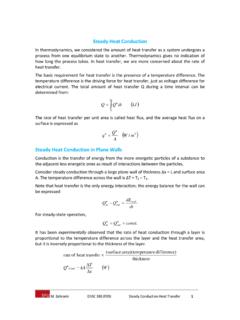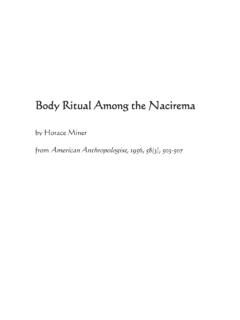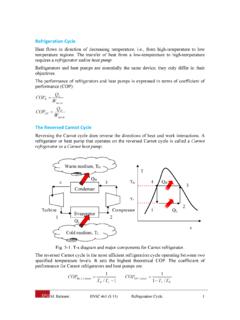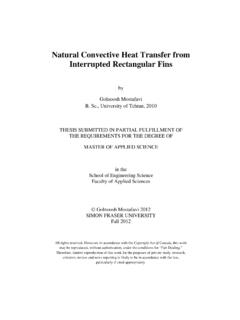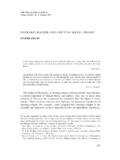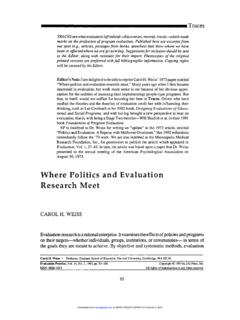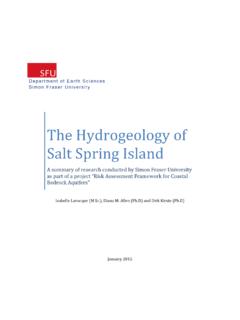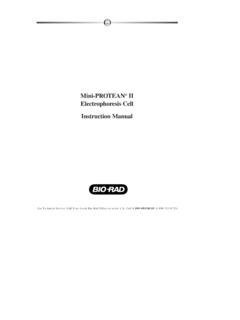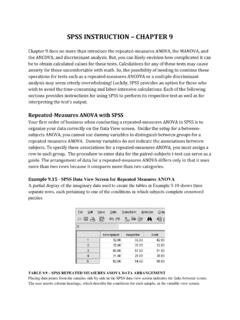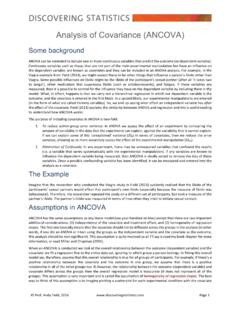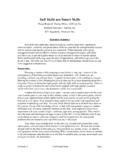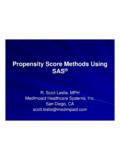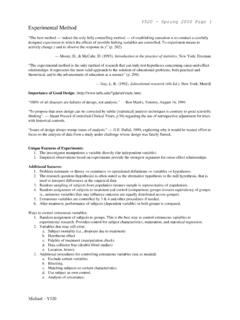Transcription of When to Use a Particular Statistical Test - SFU.ca
1 When to Use a Particular Statistical TestUnivariate DescriptiveCentral TendencyMode the most commonly occurring valueex:6 people with ages 21, 22, 21, 23, 19, 21 - mode = 21 Median the center value the formula is N+1 2ex:6 people with ages 21, 22, 24, 23, 19, 21 line them up in order form lowest to highest 19, 21, 21, 22, 23, 24and take the center value - mode = the mathematical average the formula is 3X/Nex:mean age = age of person one + age of person two + age of person three, ofpeopleVariance a measure of how spread out a distribution is it is computed as the average squared deviation of each number from its meanStandard Deviation how much scores deviate from the mean it is the square root of the variance it is the most commonly used measure of spreadBi- and Multivariate Inferential Statistical TestsDifferences of GroupsChi Square compares observed frequencies to expected frequenciesex:Is the distribution of sex and voting behavior due to chance or is there a differencebetween the sexes on voting behavior?
2 T-Test looks at differences between two groups on some variable of interest the IV must have only two groups (male/female, undergrad/grad)ex:Do males and females differ in the amount of hours they spend shopping in a givenmonth?ANOVA tests the significance of group differences between two or more groups the IV has two or more categories only determines that there is a difference between groups, but doesn t tell which isdifferentex:Do SAT scores differ for low-, middle-, and high-income students?ANCOVA same as ANOVA, but adds control of one or more covariates that may influence the DVex:Do SAT scores differ for low-, middle-, and high-income students after controlling forsingle/dual parenting?MANOVA same as ANOVA, but you can study two or more related DVs while controlling for thecorrelation between the DV if the DVs are not correlated, then separate ANOVAs are appropriateex:Does ethnicity affect reading achievement, math achievement, and overall scholasticachievement among 6 graders?
3 ThMANCOVA same as MANOVA, but adds control of one or more covariates that may influence theDVex:Does ethnicity affect reading achievement, math achievement, and overall scholasticachievement among 6 graders after controlling for social class?thRelationshipsCorrelation used with two variables to determine a relationship/association do two variables covary? does not distinguish between independent and dependent variablesex:Amount of damage to a house on fire and number of firefighters at the fireMultiple Regression used with several independent variables and one dependent variable used for prediction it identifies the best set of predictor variables you can enter many IVs and it tells you which are best predictors by looking at all of themat the same time in sequential regression the computer adds the variables one at a time based on theamount of variance they account forex:IVs drug use, alcohol use, child abuseDV.
4 Suicidal tendenciesPath Analysis looks at direct and indirect effects of predictor variables used for relationships/causalityex:Child abuse causes drug use which leads to suicidal MembershipLogistic Regression like multiple regression, but the DV is a dichotomous variable logistic regression estimates the odds probability of the DV occurring as the values of theIVs changeex:What are the odds of a suicide occurring at various levels of alcohol use?StatisticalAnalysesIndependentVariab lesDependentVariablesControlVariablesQue stion Answered by the Statistic# ofIVsData Type# ofDVsType of DataChi square1categorical1categorical0Do differences exist between groups?t-Test1dichotomous1continuous0Do differences exist between 2 groups on one DV?ANOVA1 +categorical1continuous0Do differences exist between 2 or more groups onone DV?
5 ANCOVA1 +categorical1continuous1 +Do differences exist between 2 or more groupsafter controlling for CVs on one DV?MANOVA1 +categorical2 +continuous0Do differences exist between 2 or more groups onmultiple DVs?MANCOVA1 +categorical2 +continuous1 +Do differences exist between 2 or more groupsafter controlling for CVs on multiple Dvs?Correlation1dichotomous orcontinuous1continuous0 How strongly and in what direction ( , +, -) arethe IV and DV related?Multipleregression2 +dichotomous orcontinuous1continuous0 How much variance in the DV is accounted for bylinear combination of the IVs? Also, how stronglyrelated to the DV is the beta coefficient for eachIV?Path analysis2 +continuous1 +continuous0 What are the direct and indirect effects of predictorvariables on the DV?
6 LogisticRegression1 +categorical orcontinuous1dichotomous0 What is the odds probability of the DV occurringas the values of the IVs change?Statistics Decision TreeResearchQuestionNumber andtype of DVNumber andtype of IVCovariatesTestGoal ofAnalysisGroupdifferencesnominal orhigher1 nominal orhigherchi squaredetermine ifdifferencebetween croupscontinuous1 dichotomoust-testdeterminesignificance ofmean groupdifferences1 categoricalone-way anova1+one-way ancova2+ categoricalfactorial anova1+factorial ancova2+ continuous1 categoricalone-waymanovacreate linearcombo of Dvsto maximizemean groupdifferences1+one-waymancova2+ categoricalfactorialmanova1+factorialman covaDegree ofrelationshipcontinuous1 continuousbivariatecorrelationdeterminer elationship/prediction2+ continuousmultipleregressionlinearcombin ation topredict the DV1+ continuous2+ continuouspath analysisestimate causalrelations
7 AmongvariablesPrediction ofgroupmembershipdichotomous2+ nominal orhigherlogisticregressioncreate linearcombo of IVs ofthe log odds ofbeing in onegroupWhen trying to decide what test to use, ask youself the I interested :description (association) - correlations, factor analysis, path analysisexplanation (prediction) - regression, logistic regression, discriminant analysisintervention (group differences) - t-test, anova, manova, chi squareDo I need longitudinal data or is cross-sectional data sufficient for my purpose?Do my hypotheses involve the investigation of change, growth, or the timing of an event?If longitudinal data is necessary, how many data points are needed?(We do not cover these techniques in this class, but your major advisor can direct you tothe appropriate procedure.)
8 Is my dependent variable nominal, ordinal, interval, or ratio?nominal - chi square, logistic regressiondichotomous - logistic regressionordinal - chi squareinterval/ratio - correlation, multiple regression, path analysis, t-test, anova, manova,discriminant analysisDo I have moderating or mediating variables?A moderating relationship can be thought of as an interaction. It occurs when therelationship between variables A and B depends on the level of C. A=marital satisfactionB=risk of divorceC=amount of resourcesHighLow ResourcesRisk of DivorceHigh ResourcesLowLowHighMarital SatisfactionWhen resources are low, marital satisfaction doesn t affect divorce, but at high resources,marital satisfaction predicts a greater risk of mediating relationship can be thought of as an intervening relationship.
9 It is one inwhich the path relating A to C is mediated by a third variable (B). We all know that older drivers, up to a point, are safer than younger drivers. But I'm sure that wedon t think that the aging (some would say deterioration) of the body, or the mere passage oftime, somehow leads to safer driving. What happens, as all right thinking people will agree, isthat age leads to wisdom, and wisdom leads to safer drivers. Hence wisdom is the mediatingvariable that explains the correlation between age and safe driving. (Forget the part about thedecline in driving related to being way old, that creates a curvilinear relationship and we re notgoing there.)Leerkes and Crockenberg (1999) were studying the relationship between how a new mother wasraised by her own mother 20+ years before (A=maternal care) and the new mother's level of self-efficacy as a mother (C=self-efficacy).
10 The idea being that if your mother showed high levels ofmaternal care toward you, you would feel more confident of your ability to mother your ownchild. Indeed, the correlation between Maternal Care and Self-Efficacy was .272, which is significant atp < .01. But Leerkes expected that this relationship was mediated by self-esteem, such that if youhad good maternal care, you will have good self-esteem (B=self-esteem), and if you have goodself-esteem, that will, in turn, lead you to have high C BWhen A (maternal care) and C (self-efficacy) are entered into the regression equation, A predictsC. When B (self-esteem) is added to the equation, if B predicts C and the A-C relationshipdeclines in value, that s a mediating/intervening relationship.
